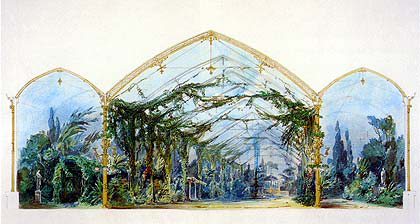Garden Museum
Room 13 – Orangeries and palm houses

The winter garden of King Maximilian II of Bavaria,
drawing by Franz Kreuter, around 1850
Orangeries are buildings where frost-sensitive plants are kept during the cold season. In the 16th and 17th centuries these were mostly wooden buildings, which were constructed around the trees and shrubs where they had been planted to protect them in the winter and were removed again in spring. A great deal of work was involved in building and dismantling these structures, which in addition lacked aesthetic appeal, and from the mid-17th century on they were replaced by permanent constructions. In the course of the 18th century these orangeries were often given magnificent façades. From this time on the plants were cultivated in tubs. In the spring the tubs were put out in the garden and in the autumn they were taken inside again. Citrus plants were especially popular, in particular orange trees, which gave the buildings their name.
Palm houses
Palms grow in tropical or subtropical climate zones. North of the Alps they are cultivated in greenhouses to protect them from the severe winters. The dimensions of these structures are usually determined by the height of the various palms, which are grouped according to type.
Then as now palms have an aura of exoticism and unspoilt nature. For this reason palm houses were not only used for collecting, researching and cultivating evergreen plants, they were also popular with the general public. The recreational element and the popularity of exotic plants also led to the building of winter gardens, which were often designed with "southern" landscapes.
The palm house was a direct consequence of the introduction of new heating techniques. It was not until steam and hot water heating came in at the beginning of the 19th century that it became possible to heat large rooms evenly. This paved the way for the glasshouse. In spite of their large cooling surfaces, constructions of iron and glass were particularly suitable for the growing of plants, since they enabled optimal use to be made of the sunlight.


Recommendation in the social media
Facebook Twitter Google Plus